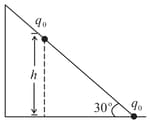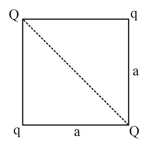Coulomb's Law
Coulomb's Law: Overview
This topic covers concepts, such as, Electrostatic Force between Two Charges in Vacuum, Coulomb's Law, Coulomb's Law in Vector Form, Permittivity of Vacuum & Permittivity of a Medium etc.
Important Questions on Coulomb's Law
Two fixed point charges units are separated by a distance ‘a’. Where should the third point charge be placed for it to be in equilibrium?
How does the coulomb force between two point charges depend upon the dielectric constant of the intervening medium?
The force of interaction between two chargesand placed at a separation is is. Then force of interaction between two charges and , placed at a separation , is
Four charges are at the corners of a square as shown in the figure. Corners A and D have equal charge, while both B and C have a charge of . What is the charge on A so that the force on B is zero?

Find the value of the net electric force on charge as shown in the following figure.

As shown in the figure, a configuration of two equal point charges is placed on an inclined plane. Mass of each point charge is . Assume that there is no friction between charge and plane. For the system of two point charges to be in equilibrium (at rest) the height . The value of is

Three point charges and are placed on axis at a distance and respectively from origin as shown. If and , the magnitude of net force experienced by the charge is _____ .

A charge is divided into two parts and placed at distance so that the repulsive force between them is maximum. The charges of the two parts are:
Four charges of are placed at the corners, , and of a square. The resultant force on the charge at
A charge is divided into two equal parts and kept at distance. Find repulsion between charges?
Two identical charges are separated by some distance repel each other with a force of . Now the charges are placed in a medium of dielectric constant , what will be new force between them.
If the distance between two charges become double, then electrostatic force between them will become
Calculate electrical force between two charge placed apart Given . Mention two smaller units of .
In the figure, if net force on is zero then value of is

The force between two charges apart is . If each charge is moved towards the other by , then the force between them will become
Calculate the magnitude of electrostatic force on a charge placed at a vertex of a triangular pyramid ( vertices,faces), if equal charges are placed at all four vertices of pyramid of side
Force of attraction between two point charges and separated by . When these charges are placed on two identical spheres of radius whose centres are apart, the force of attraction between them is
When identical point charges are placed at the vertices of a cube of edge length , each of them experiences a net force of magnitude . Now these charges are placed on the vertices of another cube of edge length . What will magnitude of the net force on any of the charges be? These cubes are simply geometrical constructs and not made of any matter.
Force of attraction between two point charges and separated by metre is . When these charges are placed on two identical spheres of radius whose centres are metre apart, the force of attraction between them is
Two small equally charged identical conducting balls are suspended from long threads from the same point. The charges and masses of the balls are such that they are in equilibrium. The distance between them is (the length of the threads ). One of the balls is discharged. After some time both balls come to rest in equilibrium. What will be the distance (in ) between the balls when equilibrium is restored?
